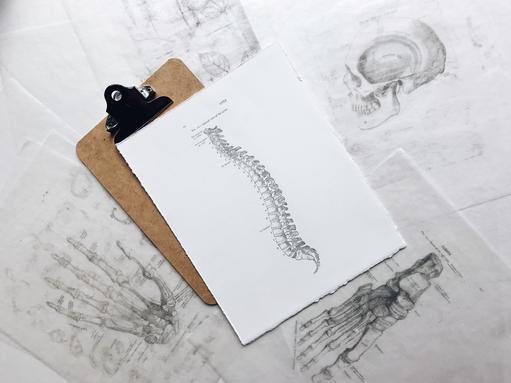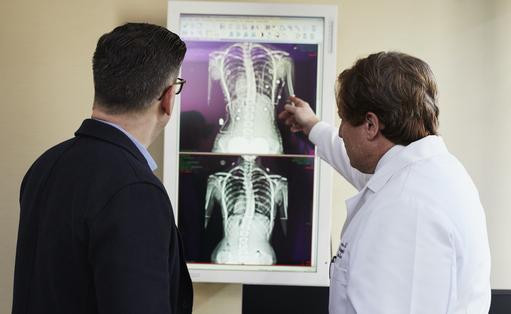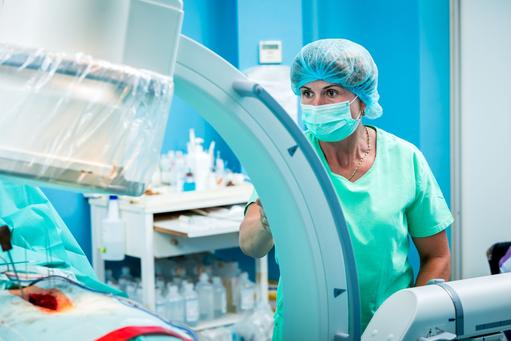- Artificial discs, 3D printing, orthobiologics, and the Internet of Medical Things (IoMT) are technologies positioned to increase their impact on the spine market
- The speed of their adoption should not be overestimated given the nature and structure of the industry
- The challenge for spine companies is not too few employees who understand the traditional spine market but too many
-Low back pain and the global spine industry-
Will a rear mirror mindset slow the adoption of technologies poised to influence the spine market?
This Commentary describes four evolving medical technologies: motion preserving spinal techniques, 3D printing, orthobiologics, and the Internet of Medical Things (IoMT). All are poised to contribute to improving the therapeutic pathways of people with low back pain (LBP) and age-related spine disorders, which cause significant disability and are common reasons for people to visit primary care doctors and A&E departments. At what speed will these technologies be adopted by the spine market?
An optimistic view suggests that by 2025, all four technologies will be commonly used in spine care. More people will be focussed on aging well, they will be better informed about their health and taking proactive rather than reactive approaches to common spine disorders and treatments. Developed nations and some emerging economies will have extended their public healthcare systems and larger percentages of their populations will have access to quality spine care. Digital inclusion will have spread, and the acceptance of scientific and technological advances will have accelerated. The spine market will have increased its use of AI, behavioural sciences, genomics, and screening and healthcare risks will have been substantially reduced. Spine companies would have shifted from being predominantly manufacturers of hardware to more solutions orientated patient-centric enterprises focused on maintaining the health and wellbeing of an ageing population in an healthcare ecosystem designed around people rather than places.
A less optimistic view is that by 2025, the spinal implant and devices market will continue to be conflicted between increasing patient demands and the level of evidence for various spine care options. This will perpetuate the current system, which leaves clinicians obligated to provide treatments based on insufficient information. Entering this environment will be an increasing supply of spine surgeons trained to deliver interventional care, and economic incentives for them to perform surgical procedures with increasing frequency. Due to decreasing fertility rates and increasing life expectancy, there will be >0.8bn people ≥65 years: ~11% of the global population, (~19% and ~21% respectively of the populations of the US and Europe). The result will be a spine care ecosystem that: (i) continues to emphasize the performance of narrowly focused and insufficiently studied procedures to address what are complex biopsychosocial pain problems and (ii) eschews technologies outside a relatively narrow surgical bandwidth. This will support a business-as-usual mindset among spine companies, and in turn, slow the adoption rates of technologies described in this Commentary.
Motion preserving spinal techniques
Spinal fusion, which permanently connects two or more vertebrae in your spine and eliminates motion between them, is one of the most performed spinal procedures indicated for a wide range of spinal conditions. Given that people are ageing and living longer after spinal surgery, there is the beginnings of a movement away from the gold standard spinal fusion-based solutions towards motion preserving surgery. This aims to maintain normal, or near normal, motion to prevent adverse outcomes commonly seen with conventional spinal fusion, most notably the development of adjacent-level degenerative disc disorders.
|
|
Several different surgical approaches have been developed to preserve motion in the lumbar spine, including total disc replacement (spinal arthroplasty), partial disc (nucleus) replacement, interspinous spacers, dynamic stabilization devices, and total facet replacement devices. The design of artificial (manufactured) discs varies, but all aim to stabilize the spine and eliminate pain while conserving natural motion of the functional spinal unit, which is essential for mobility, walking, reaching, and having the stamina to participate in activities for periods of time.
|
|
Motion preserving technologies were introduced ~2 decades ago. In 2004, DePuy’s Charité Artificial Disc received FDA approval for the treatment of LBP due to a damaged or worn out lumbar intervertebral disc. Since then, more than a decade passed before AESCULAP’s activL® Artificial Disc received FDA approval in 2015. Findings of a 2016 clinical study suggest that, “the activL® Artificial Disc results in improved mechanical and clinical outcomes versus an earlier-generation of artificial discs and compares favorably to lumbar fusion”. In 2019, RTI Surgical, an implant company, acquired Paradigm Spine, a privately held company, for US$300m. Paradigm manufactures Coflex, an FDA approved spine motion preserving solution.
Some artificial discs adapt traditional titanium implants with specialized coatings and advanced surfacing to allow for a smoother press-fit fixation and future bone ingrowth, which is expected to keep the new discs more securely located. Despite growing enthusiasm for motion preserving spinal techniques, their utilization rates have remained relatively low. This may be attributable to size constraints of available total disc replacements (TDR), stringent regulatory indications for their use, difficult instrumentation, mixed clinical outcomes, and reimbursement challenges. Despite these headwinds, the artificial disc market surpassed US$1.6bn in 2019, and its compound annual growth rate (CAGR) is expected to be >18% for the next five years. The US represents >50% share of this market.
The wider adoption and growth of motion preserving techniques for the treatment of low back pain (LBP) and degenerative disc disorders will depend on the long-term outcomes assessed by controlled randomized clinical studies of spinal arthroplasties. As studies demonstrating the efficacy for TDRs increase and the procedures become more established, incidence rates of traditional spinal fusions are likely to slow.
3D printing
3D printing, also known as “additive manufacturing”, facilitates the conversion of computer-added anatomical images into physical components using special printers, which add successive layers of material. The technology is believed to be particularly suited to the complex anatomy and the delicate nature of spine surgery and is used for spinal implants, pre-operative surgical planning, intra-operative guidance, customised and off-the-shelf devices as well as patient–clinician communications, and medical education. Reports suggest that 3D printing enhances procedural accuracy, decreases surgical time and improves patient outcomes.
Over the past decade, 3D printed spinal implants have developed and grown as access to the technology improved. Today, 3D printed spinal implants are being created from materials such as porous titanium, which has the benefit of being strong and durable as well as achieving faster bone growth and osseointegration than conventional PEEK (polyetheretherketone) implants. Increasingly, 3D printing is being used in the pre-operative planning stage for spine surgery by providing a full-scale, stereoscopic understanding of the pathology, which allows for more detailed planning and simulation of a procedure. It is also used to create intra-operative guides for placing pedicle screws using patient-specific data, which lowers risks. [Pedicle screws are fixations routinely used in spinal surgery to stabilize vertebrae. The placing of the screws is dependent on the experience of the surgeon and can result in a breach of the pedicle and cause complications and injury].
|
|
Another advantage of 3D printing for spinal surgery is its ability to manufacture customised, patient-specific devices for difficult to treat cases. With traditional off-the-shelf implants, patients run an increased risk of a suboptimal fit into the reconstructive site. Although research on 3D patient specific implants is limited, they are expected to have enhanced durability due to a more even load distribution and superior osseointegration. The cases of 3D printed customised implants performed to-date have been limited to anatomically challenging pathologies where an individualized solution to restore patient-specific anatomy is a key prognostic factor.
|
|
3D printing is also used to manufacture off-the-shelf implants. Spine companies, such as 4Web Medical, and Stryker, are beginning to extend their use of 3D printing techniques to optimise the properties of implants, including the ability to mimic the interconnected structure of cancellous bone [a meshwork of spongy tissue of mature adult bone typically found at the core of vertebral bones in the spine]. In the future, it is expected that 3D printing techniques will be used to incorporate more innovative features into spinal implants, such as porous matrices where density, pore diameter and mechanical properties can differ in different regions of the implant.
As 3D printing evolves and becomes cheaper, faster, and more accurate, its use in spine surgery is likely to become routine in a range of procedures. The production of 3D orthopaedic and medical implants is estimated to grow at a CAGR of 29% between now and 2026, of which spinal fusion devices are expected to be one of the fastest-growing segments. Stryker, which has novel spinal implants comprised of highly porous titanium, has invested €200m (~US$226m) in its Instrument Innovation Centre and the Amagine Institute, in Cork, Ireland, which are focussed on the development of 3D printed spine products.
However, currently, there are only a handful of vendors that design and manufacture medical grade 3D printers. Spine companies are constrained by the limited availability of such machines and typically are not privy to certain proprietary aspects of the manufacturing process. In addition, 3D printing is more costly and time consuming than conventional manufacturing processes. The FDA has issued guidance for “patient specific” 3D implants, but as of July 2021, it has not issued a standardized framework for 3D spinal implants to be approved. This regulatory challenge can make surgeons and hospitals hesitant to use the technology. A study of 3D printed surgical implants published in the July 2019 edition of The Lancet suggests that, “Comprehensive and efficient interactions between medical engineers and physicians are essential to establish well designed frameworks to navigate the logistical and regulatory aspects of 3D printing to ensure the safety and legal validity of patient-specific treatments”. As the body of research continues to grow, larger scale studies and longer-term follow ups will enhance our knowledge of the effect 3D printing has in spinal surgery.
Orthobiologics
Compared to the introduction of innovative spine surgical techniques such as computer assisted navigation (CAN), minimally invasive spine surgery (MISS) and surgical robotic systems, the cadence for new spinal implant materials has been relatively slow to impact the market: titanium and cobalt chromium remain common choices for spinal implants.
One reason for this is because the biology of spinal fusion is a complex process that mimics bone healing after a fracture. Techniques used to enhance spinal fusion include stabilization with metallic or polymeric implants, grafting with bone products and more recently augmenting grafts with a variety of biologic agents. With autologous [patient’s own tissue], and allogenic [donor tissue] bone grafts, tissue is often manipulated to remove mineral content and/or maintain a cell population to enhance fusion.
Although autologous bone grafts remain the gold standard, concerns about their failure to achieve fusion has prompted the evaluation of an increasing range of new biologic materials. These new materials are synthetic, and are generally composed of ceramic or bioactive glass. Recombinant growth factors [proteins derived from a combination of materials that stimulate cell growth], most commonly bone morphogenic protein 2, are sometimes added because they are potent stimulators of bone formation. However, morphogenic protein 2 can be associated with enhanced risks.
|
|
|
A growing number of mid-size and smaller biotech companies engage in the production of orthobiologics. Thus, there is a growing number of new biologic agents specifically developed for spinal implants coming onto the market. These tend to be more durable and bio-friendly than traditional implants and have the potential to improve recovery times for patients and minimize soft tissue disruption.
|
|
Two examples of new biologic materials used in spine surgery for improving bone growth and fighting infection are Xiphos™-ZFUZE™, and molybdenum rhenium (MoRe).
The former is a new interbody fusion system designed to provide an alternative to the more commonly used titanium and PEEK spinal implants. It’s developed by Difusion Technologies, a biotech company based in Austin, Texas, and received a 510(K) FDA clearance in November 2019. Xiphos™ is the first spinal implant created from ZFUZE™; which is a new biomaterial specifically engineered to interact with the human immune system so that it does not attack the spinal implant as a foreign body. Such foreign body responses can lead to long-term chronic inflammation and a significant number of patient complications. Studies suggest that ZFUZE™ is superior to nano-surfaced titanium and conventional PEEK materials.
The latter, MoRe, is a new biomaterial for spine surgery, which received FDA approval in 2019, and is produced by MiRus Bio, a US biotech company founded in 2016. MoRe is compatible with MRI and CT scans, and is also corrosion resistant. The material is reported to be two to three times stronger, and more fatigue resistant, than either titanium or cobalt chromium. This is significant for the spine market where rods used in surgical constructs can break. It is also reported that MoRe is >2X more hydrophilic [a strong affinity to water and mixes well] than titanium. Spinal implants that contain MoRe have double the osseointegrative characteristics of 3D printed titanium spinal implants. MiRus has ~14, 510(K) clearances from the FDA and >150 patents in its portfolio and is well positioned to address increasing unmet needs in this segment of the spinal implant market.
With an increasing array of biologic interbody graft materials available for use in spine surgery, maintaining a comprehensive understanding of their characteristics, benefits and drawbacks is becoming increasingly important. As these new materials enter the market, traditional titanium or cobalt chromium implants are likely to be surpassed, and as they become more diverse and more widely used, their characteristics, cost effectiveness and efficacy in specific patient populations will need to be better understood and communicated to assist hospitals and surgeons to select materials that are optimal for their patients.
Despite the desirability of such a register, it is unlikely that it will materialise in the medium term given security issues, the large and escalating number of producers, patients, hospitals, and surgeons, which are dispersed and have little or no incentive to provide implant information to a central register. Further, independent studies on orthobiologics tend to be relatively weak and patchy. Thus, it seems reasonable to suggest that, in the near to medium term, purchasing parties will continue to be influenced by producers’ marketing endeavours.
Internet of Medical Things
Most spine companies are manufacturers, which are focussed on hospitals, surgeons, and operating rooms. However, hospitals, looking to reduce their expenditures on implants and devices, have formed purchasing syndicates, concentrated purchasing to a narrow range of trusted offerings and changed their reimbursement policies.
|
|
|
Vast and escalating healthcare costs, ageing populations, advancing medical science and technologies, more stringent reimbursement policies, and stricter regulations conspire to nudge conventional spine companies to shift away from their traditional production processes and move towards solutions-based, patient-centric endeavours. The Internet of Medical Things (IoMT) can help to facilitate this. Some spine companies have reinvented themselves to become more solutions-orientated and patient-centric. However, for such new business models to be sustainable, companies will need to make data management a core, rather than a peripheral, capability.
|
|
A typical treatment journey for a patient with LBP and degenerative disc disorders includes: the presentation of symptoms, diagnostic tests, treatments, monitoring and rehabilitation. This usually involves interacting with several healthcare functions and a range of equipment and devices, including MRI and CT scanners, blood pressure and heart monitors, surgical instruments, implants, and software applications as well as a range of healthcare professionals, systems, and services. Advances in wireless technology, the miniaturization of medical electronics, and the increased power of computing create opportunities for the IoMT to connect all these disaggregated entities and retrieve from them a range of relevant clinical and scientific data, which can be used to improve a patient’s therapeutic pathway.
The IoMT is an amalgamation of sensors, software, data management, and networking technologies and is driven by: (i) the general availability of affordable broadband Internet, (ii) almost ubiquitous smartphone penetration, (iii) increases in computer processing power, (iv) enhanced networking capabilities, (v) miniaturization, especially of computer chips and cameras, (vi) the digitization of data, (vii) growth of big data, Cloud-based repositories, and (viii) advances in AI, machine learning (ML), and data mining. This provides the potential for common spinal implants and devices to become ‘intelligent’ by having the added capability to retrieve, analyse and communicate clinical and scientific information. The IoMT can assist spine companies to streamline their clinical operations and workflow management, enhance patient outcomes, lower costs and transform their role and relationship within the evolving value-based healthcare ecosystem.
Indicative of this is Canary Medical, a privately held Canadian company founded in 2013, which uses IoMT to enable remote monitoring of patients’ implants. Starting with artificial knees, Canary’s technologies provide real-time feedback on how surgical implants and devices are working by generating self-reports on patient activity, recovery, and treatment failures, without the need for physician intervention and dependence upon patient compliance. Canary applies machine learning algorithms to the data it collects to identify patterns that could help clincians catch problems, such as infections or loosening of the joints before they worsen.
The COVID-19 crisis forced physicians to use more remote services. It seems reasonable to assume that over the next five years this will increase, remote monitoring will become the norm, and the value of data generated by spinal implants and devices will be significantly enhanced. The growing importance of data, which are derived from implants and medical devices, is evidenced by the fact that the FDA has embraced AI and has several ongoing projects designed to develop and update regulatory frameworks specific to it. A research paper published in the January 2021 edition of The Lancet Digital Health demonstrates the increasing significance of data and algorithms for MedTech’s. In 2015, the FDA approved nine AI-machine learning (ML) based medical devices and algorithms. The number increased to 12 in 2016, 32 in 2017, 67 in 2018, and a further 77 in 2019. In Q1,2020, 24 AI/ML-based medical devices were approved by the FDA.
Canary is unusual as the spine industry generally has been relatively slow to embrace the IoMT. This partly could be associated with security and privacy issues. However, according to a July 2018 report from Deloitte, a consulting firm, there are, “more than 500,000 medical technologies currently available, which all share a common purpose: having a beneficial impact on people’s health and quality of life” and all are currently accessible to collect, analyse and transmit healthcare data. The increasing significance of data also is stressed in another research report by Deloitte on the European MedTech industry. Findings suggest that AI technologies, which, “can be used across the entire patient journey”, save European healthcare systems “~€200bn (~US$238bn) each year” and “have the potential to assist European health systems in responding to major challenges they face”.
A February 2020 Fortune Insights Report, valued the global IoMT market at ~US$19bn, and projected it to reach ~US$142bn by 2026, exhibiting a CAGR of ~29%. Given the growing significance of the IoMT to the spine market, in the medium term, data could become more valuable than actual spinal implants and devices. Spine companies need to consider developing new business models to take advantage of this and develop a deeper understanding of the needs of patients and demonstrate how their offerings improve patients’ therapeutic journeys.
Takeaways
Because the risks associated with spine surgery are non-trivial and reducing complications is critical, over the next decade we are likely to see the introduction and adoption of technologies, which have the potential to improve precision, enhance patient outcomes and reduce costs. These, together with technologies described in previous Commentaries, provide companies with an opportunity to influence how the spine market will play out over the next decade. However, the speed that the technologies described in this Commentary will be adopted by the spine market should not be overestimated given the deep-rooted interests and established practices of the industry. To take advantage of these developing technologies spine companies will need to stay ahead of consumer-focussed tech-savvy companies, like Canary, which are entering the market and: (i) increase their digital expertise, (ii) improve their patient-centric interactions, (iii) enhance their data management capabilities, and (iv) extend their digital infrastructures. Over the next 5 years, a challenge for spine companies will not be a lack of executives who understand traditional spine markets, but an excess of them. Executives who know the traditional spinal implant and devices industry well, are likely to keep looking in their rear-view mirrors and assuming that what made money in the past will make money in the future.
|
|
|
|





 1 comment
1 comment





 HealthPad
HealthPad















